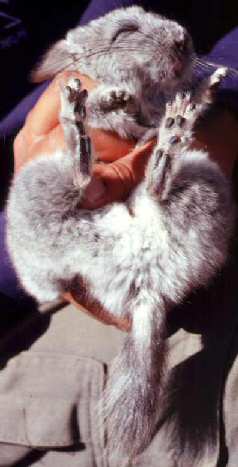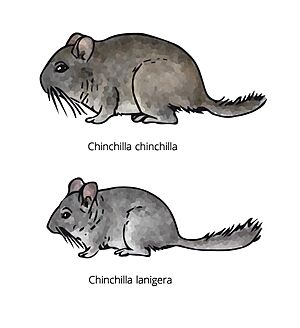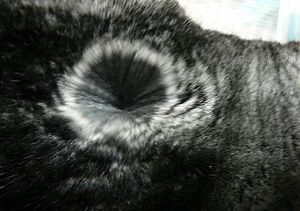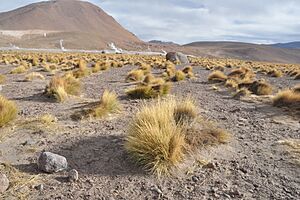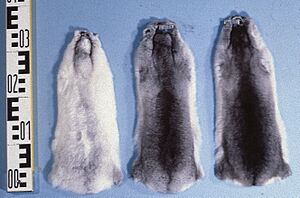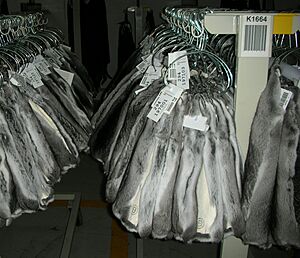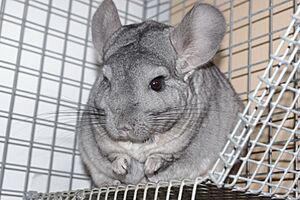Short-tailed chinchilla facts for kids
Quick facts for kids Short-tailed chinchilla |
|
|---|---|
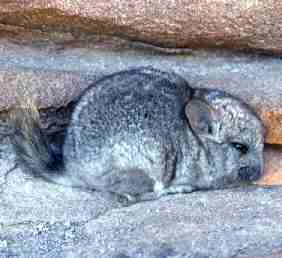 |
|
| Conservation status | |
| Scientific classification | |
| Genus: |
Chinchilla
|
| Species: |
chinchilla
|
 |
|
| Past range of Chinchilla chinchilla. | |
| Synonyms | |
|
|
The short-tailed chinchilla (Chinchilla chinchilla) is a small rodent that belongs to the Chinchillidae family. It is known for its incredibly soft fur. This animal is currently listed as an endangered species by the IUCN. This means it is at a very high risk of disappearing forever.
Short-tailed chinchillas originally came from South America. They are part of the Chinchilla group, which includes two main types: the long-tailed chinchilla and the short-tailed chinchilla. In the past, short-tailed chinchillas lived in Chile, Argentina, Peru, and Bolivia. However, their living areas have shrunk a lot. Today, they are mostly found in the Andes mountains of northern Chile. Small groups have also been seen in southern Bolivia.
These chinchillas have grayish-blue fur that is very thick and soft. Their short, furry tail helps tell them apart from the long-tailed chinchilla. Compared to the long-tailed chinchilla, the short-tailed chinchilla has smaller, rounder ears and is a bit smaller overall.
For hundreds of years, people have hunted chinchillas. Commercial hunting for their fur started in Chile in 1828. This led to a huge demand for their pelts in Europe and the United States. As more people wanted chinchilla fur, the number of chinchillas dropped sharply. By 1917, they were thought to be extinct. A ban on hunting chinchillas was put in place in 1929, but it wasn't strictly enforced until 1983. Even though they were rediscovered in the wild in 1953, their numbers kept falling.
Many things threaten short-tailed chinchillas today. These include illegal hunting, loss of their homes, cutting down trees for firewood, and mining. In recent decades, chinchillas have also become popular as exotic pets. This has led to more hunting and trapping.
Contents
Appearance and Features
Short-tailed chinchillas are generally smaller than long-tailed chinchillas. You can tell them apart by looking at their body length, head size, tail length, and ear size. Short-tailed chinchillas often look like they have a bigger body, thicker neck, wider shoulders, and smaller ears. Their tail is a key difference. Short-tailed chinchillas have tails up to 100 millimeters (about 4 inches) long. Long-tailed chinchillas have tails up to 130 millimeters (about 5 inches) long. They have wide heads with small cheek pouches.
A short-tailed chinchilla's body is usually between 23 and 38 centimeters (9 to 15 inches) long. They weigh about 400 to 800 grams (about 1 to 1.7 pounds). Young chinchillas weigh between 113 and 170 grams (4 to 6 ounces). Pet chinchillas are often larger, sometimes twice the size of wild ones. In both wild and pet chinchillas, females are bigger than males. This size difference is more noticeable in pet chinchillas. Both male and female short-tailed chinchillas look similar, except for their size.
Short-tailed chinchillas have a very thick coat of super fine hair. Their fur is incredibly soft because many hairs grow from a single follicle. A chinchilla follicle can hold up to 50 hairs. In comparison, human hair follicles usually have just one hair. Chinchilla fur is very valuable and is considered the softest in the world.
Their fur color can be different for each chinchilla. Colors include violet, sapphire, blue-grey, beige, brown, ebony, gray, white, cream, and pearl. Each hair usually has a black tip. The fur on their belly is typically a cream or off-white color.
The tail is usually bushy and has rougher hair. The chinchilla's thick fur helps it survive in the cold Andes mountains. This dense coat also prevents water from evaporating, keeping the chinchilla warm. Also, the fur is so thick that fleas and other tiny bugs cannot get through it. This often causes them to suffocate. However, chinchillas cannot pant or sweat. Their thick fur can make them overheat, especially when kept as pets. Their natural way to cool down is by pumping blood through their ears, which have finer hair.
Chinchillas are very well-suited to their mountain homes. They have short front legs and long, strong back legs. These help them climb and jump in the mountains. Short-tailed chinchillas can jump across gaps up to six feet wide. They have large feet with soft pads and weak claws. This allows them to move over rocks without slipping. Short-tailed chinchillas have very long whiskers, called vibrissae. They can be about 100 millimeters (4 inches) long. Their large eyes have vertical pupils, giving them a clear, wide view at night. Their big ears help them hear faint sounds and listen for predators.
Behavior and Habits
Not a lot is known about short-tailed chinchilla behavior because they are shy. However, they are known to be very smart. In the wild, they are timid and stay hidden during the day to avoid animals that might hunt them. Chinchillas are crepuscular. This means they wake up at dawn and dusk to find food. They use their long whiskers to find their way and search for food in the dark.
At dawn, chinchillas enjoy sunbathing and grooming themselves by taking dust baths. In the wild, chinchillas living in the Andes Mountains roll in volcanic ash. This coats their fur and prevents it from getting matted from skin oils. Pet chinchilla owners often give them special dust or sand baths. This helps spread oils, clean dirt, and keep their fur soft.
Social Life
Chinchillas are social animals. They usually live in groups called herds. These groups can have anywhere from a few chinchillas to a hundred individuals.
Reproduction and Life Cycle
Short-tailed chinchillas usually have one mating partner and are considered monogamous. Female chinchillas are a bit larger than males and often are in charge. They usually mate twice a year. The breeding season is from November to May in the Northern Hemisphere. Their gestation period, or pregnancy, lasts for 128 days.
Females can have up to two litters of babies a year. Three litters are possible but not common. A litter usually has one to six babies, called kits, with two being the average. Newborn chinchillas can eat plant food soon after birth. They stop drinking their mother's milk at about 6 weeks old. Short-tailed chinchillas become adults quite quickly, usually around 8 months old. Some pet chinchillas have been seen to mature as early as 5.5 months. In the wild, short-tailed chinchillas typically live for 8–10 years. In captivity, they can live much longer, sometimes 15–20 years.
An interesting thing about female chinchillas is that other nursing females sometimes feed the young of others if the mother cannot produce milk. Unlike many rodent species, father chinchillas also help care for their babies. They look after the young when the mother is out finding food.
How They Defend Themselves
While not usually aggressive, pet chinchillas might nip if not handled gently. If a predator bites or nips a chinchilla, it can release clumps of its hair to escape. This leaves the predator with a mouth full of fur and is called a "fur slip." A fur slip also happens with pet chinchillas if owners hold them too tightly or if the chinchilla is stressed.
Sounds They Make
Short-tailed chinchillas use different sounds to communicate. They have about ten distinct sounds, and each means something different depending on the situation. Chinchillas will make a whistle-like sound, growl, or chatter their teeth to warn others of danger. They have also been known to make hiss-and-spit noises if bothered. When mating, they might make a cooing sound.
Where They Live
Short-tailed chinchillas mostly live in burrows they dig themselves. They also live in rocky cracks where there are shrubs and grasses nearby. Their homes are usually in mountainous grasslands. Their habitat often has scattered thorny shrubs, cacti, and patches of succulents. Chinchillas live in dry, high-altitude places where temperatures drop at night. Because of their environment, chinchillas have adapted to use less energy. They have a slow metabolism. Chinchillas are active at night, often looking for food at dusk and dawn.
Where They Are Found
Historically, short-tailed chinchillas lived in the Andes mountains. They were native to Peru, Chile, Bolivia, and Argentina. There has been some thought that chinchillas might have disappeared from Bolivia and Peru. In Bolivia, chinchillas used to live in the La Paz, Oruro, and Potosi regions. The last wild ones were caught near Sabaya and Caranga. However, a small group was recently found in Bolivia near the Laguna Colorada basin.
Today, short-tailed chinchillas have only been seen in the Andes Mountains of northern Chile. They are found only in this area. In Chile, chinchilla groups have been seen near El Laco and Morro Negro. Both are close to the Llullaillaco volcano in the Antofagasta region. They have also been seen near the Nevado Tres Cruces National Park in the Atacama region.
Their Range
Their living area stretches through the mostly barren parts of the Andes Mountains. They live at elevations from 3,000 to over 5,000 meters (9,800 to over 16,000 feet).
What They Eat
Chinchillas eat mostly plants. Their diet mainly consists of grasses and shrubs found on mountain sides. Short-tailed chinchillas are herbivores. This means they eat only plants. They mainly feed on high-fiber plants like leaves, shrubs, seeds, nuts, grasses, herbs, flowers, and grains. Short-tailed chinchillas also compete for food with other animals that eat plants, like goats and cattle. Sometimes, they will eat insects. Their diet changes with the seasons, depending on what plants are available. A common food is the perennial Chilean needle-grass.
Short-tailed chinchillas get their drinking water from morning dew or from the juicy parts of plants like cacti. When eating, the short-tailed chinchilla sits upright and holds its food with its front feet. Chinchillas can eat too much if there is a lot of food available. So, pet owners must be careful not to overfeed them. Chinchillas also gnaw on things to keep their teeth worn down, as their teeth grow constantly.
History and Arrival in the U.S.
The ancient Incas hunted chinchillas and kept them as pets. In the 1700s, commercial hunting of chinchillas began in Chile. Short-tailed chinchillas were first brought to the U.S. in the 1920s by a mining engineer named Mathias F. Chapman. Chapman loved chinchillas. He received permission from the Chilean government to bring 12 chinchillas to the U.S. He made sure the chinchillas got used to their new home slowly. Over a year, he gradually moved the chinchillas to a lower altitude. He also fed them food from their natural habitat.
Threats to Their Population
Natural Predators
Chinchillas have natural predators in the wild, both on the ground and in the sky. Birds like owls and hawks may swoop down and catch chinchillas. On the ground, snakes, wild cats, and foxes hunt chinchillas. In the three known chinchilla populations, the Andean fox is the main predator. However, chinchillas are quick and can run up to 15 miles per hour. This helps them escape predators.
Habitat Loss
Short-tailed chinchillas are affected by human activities like mining and cutting down trees for firewood. Mining operations are a big threat to chinchillas because they destroy their homes. In Chile, gold has been found in some areas. Mining these areas would disturb chinchilla populations. A major threat to chinchillas is the burning and harvesting of the algarrobilla shrub, which is their natural home.
Chinchillas are very well-adapted to their environments. Any long-term change to their environment threatens their survival. When hunting chinchillas for their pelts, fur traders used dynamite to destroy their burrows. This forced the chinchillas out, but it also killed many of them. These events have caused a 90% decrease in the short-tailed chinchilla population. They also caused them to disappear from three of the four countries where they once lived.
Fur Trade
Many chinchillas are hunted for their fur and meat. They are often bred for the pet and fur trade. Chinchilla fur is very fine and dense. One of their hair follicles can hold 50 hairs, while humans usually have 1 hair per follicle. Chinchilla fur is highly valued and in demand in the fur industry. Commercial hunting began in 1829. It increased every year by about half a million skins. Demand for fur and skins grew in the United States and Europe. The continuous and intense hunting was not sustainable. The number of chinchillas hunted declined until the resource was considered economically extinct by 1917.
Once hunting started, the demand for chinchilla skins grew very quickly in the United States and Europe. This caused an unsustainable decline in living chinchillas. The supply of chinchillas slowly decreased. The last short-tailed chinchilla was seen in 1953. This caused skin prices to increase greatly. Short-tailed chinchillas were especially sought after because their fur was higher quality and they were larger than long-tailed chinchillas.
Exotic Pet Trade
Short-tailed chinchillas are very rare. Their wild groups were only recently rediscovered. Because of this, they are not usually found in the pet trade. Instead, their close relatives, long-tailed chinchillas, are often kept as pets. They are sometimes mistaken for their short-tailed cousins. It is very unlikely that early mixes of short-tailed and long-tailed chinchillas have ever been part of the wildlife trade.
Conservation Efforts
The number of short-tailed chinchillas has dropped by 90% over the years. This is due to hunting and trapping for the fur trade. In the early 1900s, people hunted chinchillas in huge numbers. Over 20 million individuals were killed. By the 1960s, both types of chinchilla, C.langiera and C.chinchilla, were thought to be extinct in the wild. It wasn't until 1983 that short-tailed chinchillas were rediscovered.
Short-tailed chinchillas faced the most hunting in the early 1900s. South American fur traders were selling chinchilla furs to Europeans. To meet the growing demand for chinchilla fur in Europe, Andean fur traders had to hunt in large numbers. As the fur trade became very successful, many people quit their jobs as miners and farmers to become hunters.
Many cruel hunting methods were used to get chinchilla skins. These included using dogs to hunt them or putting burning thorny shrubs into their burrows. Others crushed chinchillas with large rocks. Throughout the late 1800s and early 1900s, half a million chinchilla skins were exported by Chile. However, because of these harsh practices, only about one-third of the exported skins could actually be sold. Buenos Aires exported most of the skins, including those from Bolivia. At this rate of hunting, the short-tailed chinchilla became extinct in Chile, Bolivia, and Argentina.
Today, only three groups of short-tailed chinchillas are known. They are regionally extinct, except in Chile. However, small groups have been rediscovered in Bolivia. In Bolivia, the short-tailed chinchilla is labeled as Critically Endangered. But in Peru and Argentina, C.chinchilla is still labeled as Critically Endangered or Endangered instead of Extinct. In Chile, the species is Endangered. Chile has three regions where C.chinchilla can be found. In the Tarapacá region, they are considered "Extinguished." In the Antofagasta and Atacama regions, they are "Endangered."
Specific Conservation Actions
In 1929, the first successful law protecting chinchillas was passed in Chile. It banned hunting them. However, these laws were not effectively enforced until 1983. That's when the Reserva Nacional Las Chinchillas was created in Auco, Chile. Because short-tailed chinchillas were close to extinction, conservation measures were put in place in the 1890s in Chile. But these measures were not regulated.
A treaty in 1910 between Chile, Bolivia, and Peru was the first international effort to ban the hunting and commercial harvesting of chinchillas. Unfortunately, this effort led to big price increases for fur. This caused even more decline in the remaining chinchilla populations.
Today, short-tailed chinchillas are still considered Critically Endangered by the IUCN. Even though commercial hunting has been illegal for the last 100 years, C.chinchilla has not recovered or returned to its former living areas. The remaining populations are small and isolated. This has led to reproductive isolation, meaning they can't easily breed with other groups. It has also caused inbreeding depression and low genetic diversity. This means they are less healthy and have a higher risk of extinction. However, some chinchillas from a wild group were moved to a breeding program. This aims to increase genetic diversity for chinchillas kept in zoos or special facilities.
Groups like "Save the Wild Chinchillas" help raise awareness about the current situation of short-tailed chinchillas. To save the species, more research and surveys are needed to find other populations. If these actions are not taken, short-tailed chinchillas risk extinction within a few years.
Chinchillas in Captivity
Short-tailed chinchillas in captivity are difficult to breed for experiments. This often leads to a high percentage of them being unable to have babies. There have been attempts to crossbreed long-tailed chinchillas and short-tailed chinchillas in captivity. A few mixed individuals have resulted from these efforts.
Interesting facts about short-tailed chinchillas
- Chinchillas that have been raised as pets are often larger than those living in the wild, sometimes almost twice the size!
- Females are usually a bit bigger than males. Males and females look very similar otherwise, with size being the main difference.
- They can jump across gaps up to six feet wide!
- Their fur is considered one of the softest furs in the world.
- In the wild, short-tailed chinchillas typically live for about 8–10 years. In captivity, with good care, they can live much longer, sometimes up to 15–20 years.
- Sometimes a female who is producing milk might feed the young of another female if that mother is unable to produce enough milk herself.
- Unlike many other rodents, father chinchillas also play a role in caring for the young, sometimes looking after the kits while the mother goes to find food.
- A unique way chinchillas defend themselves is called "fur slip." If a predator grabs a chinchilla, or if a pet chinchilla is held too tightly or is very stressed, they can release clumps of their fur. This leaves the predator with a mouth full of fur, allowing the chinchilla to escape.
- Chinchillas get the water they need from morning dew or from the juicy parts of plants like cacti.
Images for kids
See also
 In Spanish: Chinchilla de cola corta para niños
In Spanish: Chinchilla de cola corta para niños



